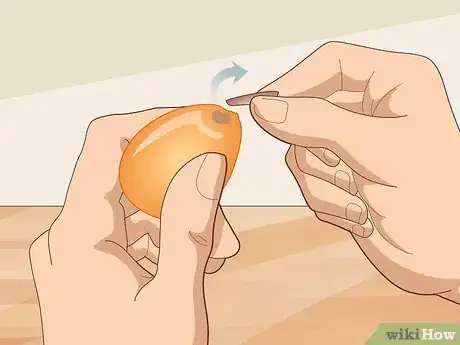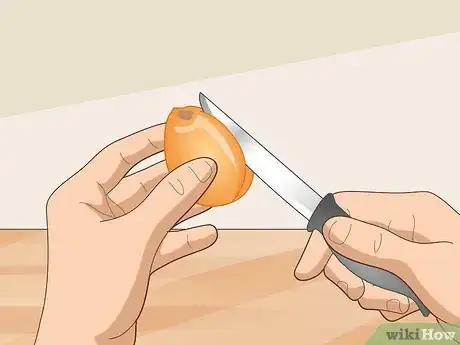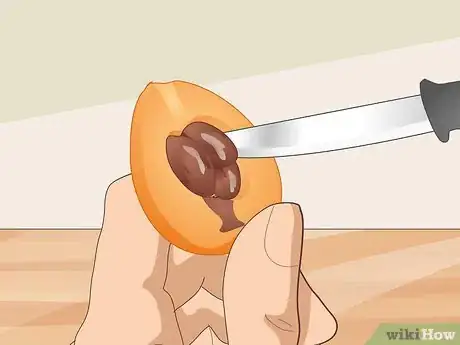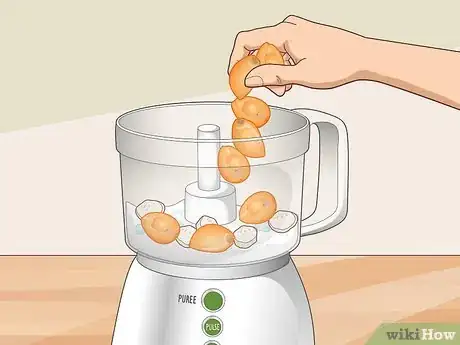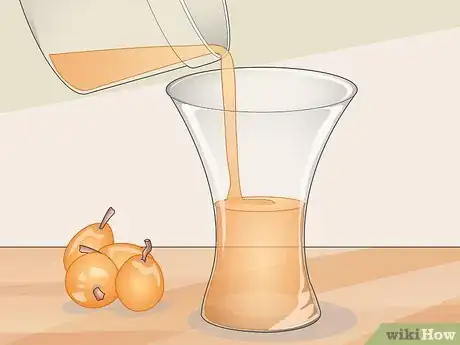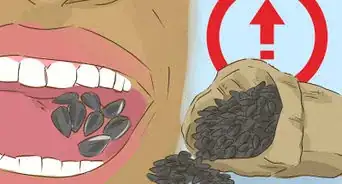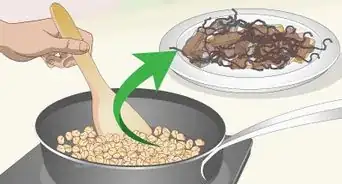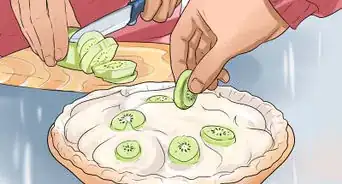This article was co-authored by wikiHow Staff. Our trained team of editors and researchers validate articles for accuracy and comprehensiveness. wikiHow's Content Management Team carefully monitors the work from our editorial staff to ensure that each article is backed by trusted research and meets our high quality standards.
There are 9 references cited in this article, which can be found at the bottom of the page.
This article has been viewed 34,904 times.
Learn more...
Loquats, also sometimes known as “Japanese plums,” “Chinese plums,” or “pipa,” are a type of tangy yellow fruit that grows on the flowering plant of the same name. With a flavor similar to peaches, apricots, and mangoes, loquats are versatile enough to be put to many different culinary uses. To open a loquat, simply cut it down the middle, pry it open, and remove the seeds. Once that's done, you can enjoy the fruit on its own or use it in any number of tasty recipes.
Steps
Cutting a Loquat
-
1Wash the loquat under a stream of cool water. While rinsing the fruit, use your fingertips to gently brush off any dirt or debris clinging to the skin. Once it's nice and clean, shake off the excess water or pat it dry with a paper towel.[1]
- Since loquats are typically eaten with the skin on like an apple, it's important to make sure they've been properly cleaned.
- A colander or wire strainer can make it easier to rinse a whole batch of loquats at once.
-
2Twist off the stem. Pinch the long, woody stem at the top of the fruit between your point finger and thumb. Give the stem a sharp twist while holding the loquat steady with your other hand. It should come away with little effort.[2]
- If the stem is giving you trouble, just cut off the entire top portion of the fruit down to about 1⁄2 inch (1.3 cm) rather than continuing to tug on it.
Advertisement -
3Slice the loquat down the center. Guide the edge of a sharp knife down through the middle of the fruit until you feel it make contact with the seeds inside. Then, rotate the loquat in your hand and continue cutting along the opposite side until you've scored the entire outer edge of the fruit.[3]
- Loquats tend to be quite small, which can make them tough to grip. Be careful not to lose control of your knife while trying to hold onto the fruit.
-
4Pry the fruit open gently. Angle the blade of your knife to one side to coax the sliced loquat open. If you encounter resistance, use your fingers to finish separating the fruit. Inside, you'll find juicy, yellow-orange flesh surrounding a core of large seeds.
- Loquats bruise easily, so try not to squeeze it too hard.
-
5Dig out the seeds with the tip of your knife. Remove the seeds delicately to avoid damaging the surrounding fruit. Most loquats contain 3-5 seeds, but you may encounter more or less depending on the species. Once you've worked the seeds out, discard them.[4]
- The seeds of a loquat are mildly poisonous, so they shouldn't be eaten with the rest of the fruit. If you happen to swallow one or two by accident, don't worry—the worst that's likely to happen is a little headache, dizziness, or upset stomach.[5]
- If the membrane around the seeds is tough, you can remove it as well by simply peeling it away.
-
6Store unused fruit in the refrigerator for up to 2 weeks. Ripe loquats should stay good for at least 7-10 days, though they may grow a little softer as they sit. For optimum flavor and texture, try to consume them as soon as possible.[6]
- To maximize the shelf life of your loquats, wrap them loosely in a plastic bag or paper towel.
- If you're already cut your loquats, their shelf life may be reduced to 2-3 days.[7]
Finding Different Ways to Enjoy Loquats
-
1Eat loquats on their own. Before you dress the fruit up too much, try it plain and see what you think. A perfectly ripe loquat should have a sweet, perfumed flavor similar to a peach or apricot, with just a hint of citrusy tartness.
- Even if you don't care for the taste of loquats on their own, you can still use them in different recipes to take advantage the host of health benefits they offer.
-
2Jazz up a fresh fruit salad by adding some loquats. Dice 1-2 cups (150-300 g) of loquats into 1⁄2 in (1.3 cm) chunks and place them in a large serving bowl with a variety of other seasonal fruits. Mix the fruit thoroughly and add a splash of orange or lemon juice to prevent it from browning. The loquats lend a unique flavor and a splash of vibrant color to the ensemble.[8]
- Use sugary fruits like strawberries, blueberries, banana, and kiwi to offset the sharp notes of the loquats.
- Loquats are fairly acidic, which means they may not pair well with other sour selections like pineapple.
-
3Blend ripe loquats into a smoothie for a unique and irresistible treat. After halving and de-seeding 4-5 loquats, toss them into a blender along with 1 banana, 1 cup (240 mL) of Greek yogurt, and 8-10 ice cubes. Feel free to incorporate any of your other favorite fruits and veggies, as well. Blend the mixture until it's smooth and free of lumps, then serve and enjoy.[9]
- Loquats also work well in green smoothies made with leafy greens like spinach and kale.#Juice your loquats to take advantage of their many health benefits. Put some peeled, diced loquats through your juicer to extract as much of their sweet nectar as possible. Loquats are very succulent fruits, which makes them ideal for juicing.
- Drink your loquat juice straight, or mix in juice from other nutritious offerings like apples, celery, berries, grapefruit, and tomatoes for a concoction that's as tasty as it is good for you.
- In many parts of the world, loquats are eaten to cure colds, treat asthma, and increase vitality, and are even believed to lower the risk of heart disease and certain types of cancer![10]
-
4Bake underripe loquats into a pie. Peel the skin from your loquats, then remove the stems and seeds like usual. Cut the fruit into halves or quarters and add the pieces to the other ingredients you'll be using to make your pie filling. Once they're baked, they'll soften up and lose some of their acidity, giving them the perfect mouth-puckering sweetness.[11]
- You can also try baking your loquats into a decadent crumble if you're short on time or looking for a simple single-serving dessert.[12]
-
5Use bruised or overripe fruits to make jam, jelly, or preserves. If you have some leftover loquats that are a little past their prime, peel and de-seed them and boil them with water, sugar, and pectin. You can use more or less fruit, depending on your preferences. Don't forget to stock up on mason jars for storing your jam or jelly when you're done![13]
- After the mixture has thickened and cooled, try spreading it on toast or biscuits, or use it to put together a loquat-inspired parfait, galette, or cake-filling.[14]
- It's easy to whip up a batch of homemade jelly or jam at home using simple ingredients and only a few pieces of cookware.
Things You'll Need
- Loquats
- Sharp knife
- Cutting board
- Paper towels
- Blender (optional)
- Juicer (optional)
- Large pot and canning accessories (optional)
References
- ↑ https://www.cleaneatingmag.com/clean-diet/loquats-the-cancer-fighting-fruit-to-try
- ↑ https://www.youtube.com/watch?v=NOn2Xa_jaP8&feature=youtu.be&t=35
- ↑ https://www.splendidtable.org/story/david-karp-loquats
- ↑ https://www.splendidtable.org/story/david-karp-loquats
- ↑ https://mainichi.jp/english/articles/20180211/p2a/00m/0na/006000c
- ↑ https://www.cleaneatingmag.com/clean-diet/loquats-the-cancer-fighting-fruit-to-try
- ↑ https://www.fruitsandveggiesmorematters.org/loquat-nutrition-selection-storage
- ↑ https://www.cleaneatingmag.com/clean-diet/loquats-the-cancer-fighting-fruit-to-try
- ↑ https://leahogg.com/2018/06/11/maltese-seasonal-fruit-loquat-and-mulberry-smoothies/
- ↑ https://www.cleaneatingmag.com/clean-diet/loquats-the-cancer-fighting-fruit-to-try
- ↑ https://www.cleaneatingmag.com/clean-diet/loquats-the-cancer-fighting-fruit-to-try
- ↑ https://www.allrecipes.com/recipe/273472/loquat-crumble/
- ↑ https://www.allrecipes.com/recipe/279883/loquat-jam/
- ↑ https://www.bonappetit.com/recipes/slideshow/jam-preserves-slideshow

